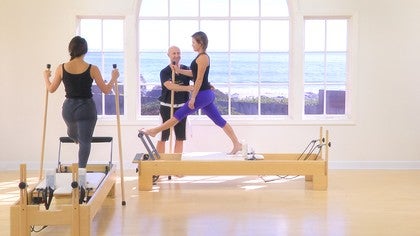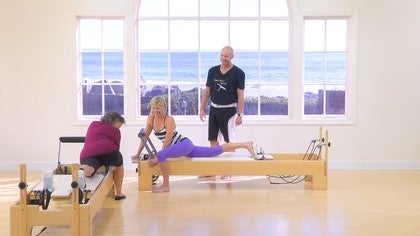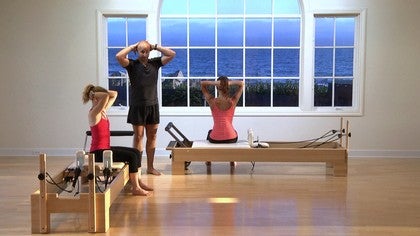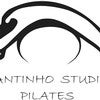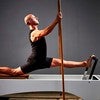Description
About This Video
Transcript
Read Full Transcript
Today, we have Kaita and Sarah joining us and I'm calling this an intermediate to advanced class because it requires a little bit more flexibility to get into some of the positions and also more strength so that you are able to hold yourself there. The other thing is that some of these stretches in the other classes that I've taught where we call them beginners stretches. They're more fragmented whereas in these classes or in these stretches, you're going to find that they are multi joint stretches. So although we might be focusing, for example on the hamstrings or the hip flexes or so on, there'll be a lot more stretching from other parts of your body and a lot more internal feedback that you'll be getting as well. Okay, so you do need kind of advanced level of body awareness, strength and flexibility for these sorts of exercises. Okay, so what we might do is we're going to start with the carbs and then we're going to work our way up through the body. We we, we're not going to warm up. I'm assuming that everyone's warmed up, otherwise that's going to take up more of our time.
So we'll go straight into our stretch and then we'll work from there. Okay. So the first one is a pretty intense CARF hamstring stretch. Um, with your spring selection. I think what you need to do is experiment a bit. It depends a bit on the type of reformer that you using, how heavy you are and how flexible you are. So for example, um, I might need a different set of springs to you Qaeda.
So for this calf on, let's start off with one red. And then if you feel like it's too difficult to hold the carriage, that's obviously too much resistance. If you feel like the character is going to fly away, you haven't got enough. Okay. So we'll start off with a red, I'll give you a quick demonstration and then we'll, we'll go from there. So you're going to start off on the carriage this way with one sword on the bar and the balls, the ball of your feet on the bar.
Try and align your heel with your sit bone. And then we're gonna to start off, we're going to straighten this leg. Okay? It doesn't matter if your background's a little bit for you to be able to get into position that that's our first position. Okay. And then the back leg doesn't do anything. You just push the carriage back a little and try and get comfortable. Okay?
So let's do that first and then we will go from there. So pick a leg, it doesn't matter which one and I'll come around behind you. So Sarah, if you slowly push the carriage out and you to cater. So remember it's very important. If you push the carriage out too quickly, your muscles won't relax. You'll find them in a protective state and you won't be able to stretch very effectively.
So push out and how's that first position? That's good. Okay. So whereabouts are you feeling the stretch? Good. That's what we want. If they said it's here or somewhere else, we might be feeling it inappropriately, but the back of the leg and the car off, maybe the back of the knee, that's where we want to be feeling it. The other thing to make sure is that your hips are aligned. So this square to the line of this leg. Okay, and let's do a contraction now.
So we're using this contract relax technique that you'll know about from some of my previous classes. So what we do here is we push the ball of the foot as if you're going to accelerate into the bar for a count of five, not using too much force. So let's do that now. So push one, two, three, four, five, stop. Take a breath in. And then as you breathe out, we're going to try and restrict. So what you do here is lower your heel a little.
How's that out of 10 in terms of intensity? Both of you.
This might give you some comfort to knowing that you're not going to hold it forever. We're going to hold the first position for five breaths. Then we're going to do our contraction for five seconds, and then we're going to raise stretch for 10 breaths. Okay? 10 slow breaths. If you're doing this at home and you've got a bit more time, 15 breaths would be even better. The longer that you hold the stretch to a degree, the more it'll be okay. So let's push the carriage out slowly.
So your leg is straight and then if you want, if it's already five or six or seven out of 10 in intensity, leave it there. If you want to make it a little stronger, lower your heel a bit more under the bar, you might, you might find that one leg is quite different to the other one as well.
Go to the other one and then come back and do the tighter side once more so that over a period of time you're addressing those muscle imbalances. Okay, lets contract. So push the ball of the foot. Remember we don't do it very strongly. Just push one, two, three, four, five. Take a breath in and as you breathe out try and lower your heel a bit more.
Okay. We won't really do that. Let's, let's bring the carriage in.
But this time we're going to stretch more the outside of your hamstring and maybe the glues a bit and maybe this part of your calf muscle. So the outer, the more lateral part. Okay. Which often gets missed out when you just do a straight linear hamstring stretch. So I'll show you the stretch quickly and then you can try it. I'm going to start off with a red and yellow spring because I'm a bit heavier than you, so I need a bit more assistance. Otherwise the carriage might fly out. Okay, so what I'll do is I'll [inaudible] put my, I'm going to put my leg across my body like this.
So you might be able to see it from this angle. The leg is across the body and then this one is in the same line. Okay? Now get into this stretch carefully. Push the carriage out and straighten that back leg straight and both legs and then square your hips. Okay? That's just the starting position there.
When you're getting out of the stretch, bring the carriage in first, then take your foot off. Okay, so kw, I might give you one more spring as well. I think it's better for the springs. It'd be a little heavier than for you to be going into the, into the front splits if you're not expecting to. Okay, so let's hop up. So, so let's say, put your left foot across in front of that shoulder. Wrist. Yep. And then carefully lift the other one. Put It on the football. Slowly straighten the back leg.
Any stretch yet? A little bit. A little bit. Okay. Yeah. That's where we want it. So what you'll find everyone is that your hips want to rotate this way. And that's because the muscles here are tight and they're pulling you around. So rotate back there, Sarah. And then when you put out a bit further, have that feel. Yeah. Okay, good. So keep those hips trying to, to, to allow any lateral tills either. So keep those hips aligned this way.
Good. So Ray, stretch slowly. Keep good. Form. That's nice. And then just go out again to wherever you can think that you can sustain this position for 10 breaths, 10 breaths, minimum. How's that feel? It was like a good stretch. Okay, good. Just watch if you're doing this at home, not that you're doing it, Sarah, but your people will have a tendency to roll that foot outwards.
So make sure that you keep the weight on that foot. Don't roll the ankle. Watch that your hips stay square and try and keep the back straight like this. Those are all adaptations that will occur because your body's taught. All right, let's bring the carriage in slightly. Remember, bring it all the way in before you take that back leg off.
Let's try the other side. Good. So the legs, the leg, if you're, if you, if you're thinking about it, your legs are in the same line. It's way good. So once you've got your foot positioned, slowly straighten that back leg. Quit this size a bit tighter. It was the same with the previous streets, wasn't it good. So again, just just don't push it as much if this one's tighter.
See if there's any area that you can let relax a bit more. Okay. Let's bring the carriage in slowly. Good. Remember why till that character's right in, and then take the back foot off. Okay. Now you're ready for the next one. So we've done really a lot of the mouth muscles running up the back of the leg.
Now we're going to combine it with the hip flexes at the front. So we're going to try and do a front split. Okay. So I think, how were those springs for that one? Supportive. Okay. Okay. Yep. Okay. So I'll get you a stick h or I'll give you two. And Sarah, you have one. So what I'm going to get you, I might just demonstrate, I'm going to get you in this position here. So the heel of the back foot is about halfway up on the shoulder, wrist, the other foot is here and the legs are parallel. Okay.
From there we'll start going down. Okay. Here we are. Okay. So put your heel at the back first, then take a big step to the front. Good. Yeah, straighten the leg for this one, Sarah, and make sure your hips are parallel. Sorry, your legs are parallel and your hips, the square to the line of the leg. Okay. How's that feel? Good. It's going to get worse.
Now what are we going to do now is slowly push the back leg back and allow your hips without letting your lower back extend or your chest go forward. Okay. So let's stop. Don't push too far first. I mean you can go further, but let's stop at the point that you feel six, six editing. Okay. If you're doing this at home, make sure your hips are square to the line of the leg because what often happens is this hip. Can I move it a bit? This hip will rotate and it becomes an adaptive stretch when we're really trying to focus on the hip flexes here. The other thing that'll happen is your lower back will hyper extend, and that's not only not good for your lower back, but it gives, gives into the stretch, so hold that tummy in it and haul that foam.
All right, now let's contract. So without letting the carriage move, push both feet down quite strongly. One, two, three, four, five. Take a big breath in. Draw the tummy in and slight talk of the tile under and then lower yourself further and you can go as far as you liked. [inaudible] okay, it looks nice. Yeah. Now just watch that lower back doesn't start hyperextending good and was the back leg. Doesn't bend because of we'll want to say tighten your quads or the VMR in particular and hold good.
Let's try one little variation. Stay there. If he can bend both knees, just a tiny bit lowly hips right now. This is what we call Ben going from bent to stripe. It's a, it's a technique that really can improve your flexibility quickly. Can you go a bit more bent? Be more down now. Hold it there and try and straighten both legs. Good. Without lifting your hips.
Okay. We better do the other side. I think so. Yeah. Put your back leg up the back heel up first and then take a big step, you know? Okay. Okay, so front leg straight. Yeah, square the hips. And then just think of your pelvis as a bucket. You're just trying to lower it without tipping any water back or forward. If anything, we want to tip a bit of water out of the back, not the front.
You're all right.
It's quite intense here through the front of the hip and that, but that's what we're trying to target. Rather than letting the back leg turn out like we do in dance, we really try to focus on the hip flexes. Okay, good. All right. You can get down and we're going to do your, your quadriceps would have been working pretty hard during that stretch I could imagine. So I'm going to show you a strength. Um, and what we might do is, let me see, I'm going to, I'll demonstrate it to you on here. Okay. So what do you need to do is hold your foot this way first and then put, don't put your knee cap on the carriage just above the knee cap in front of the shoulder, wrist, the other foot up here in line with the bar. Rotate the hips. Okay, so bring them around then pull your foot towards your bottom.
Okay. That's your first position. All right. And then we'll go from there. I'll take these and you too, I think you might, you might want to take off one spring. So you've got just, just one red one. Okay, so good. So hold that back. Hold your foot and your k there. Take your leg back a little more as you can. Let's see. So I remember, don't put your knee cap onto the carriage just above your thigh.
There is better. Good. Now again, let's do a slight tuck. Okay. Tuck that tile under. Good. And now, now if you want, pull you forward towards your bottom.
Push it back into this hand. So one, two, three, four, five, take a breath in, talk the ball Amanda, and then pull your food in a bit more.
Okay, let's come out of it slowly. Good. And we'll try the other side. So for me, yeah, you've just both done that now it's easier, I think if you hold the foot first and then get into position.
So it doesn't matter which one depends on what you want. So pull the foot in. Remember it's just five or six out of 10 to start with and now let's try the contraction. So push your foot back. So one, two, three, four, five breathing. Remember that abdominal contraction, then push your foot in. Pull it in. I mean if you've got a partner, I'll show you how they could assist. Just let go Zara, and I'll do the work for you. How's that?
Beautiful. It's important you ask your partner because you can't see them, so you need to talk with them about how it feels. How's that out of 10 okay, so it's more than enough. All right, let's come out of it slowly. If, as I said, if you've got more time, you could, you could extend that stretch because the quadriceps are such big muscles would be good to hold the stretch bit longer. So now let's move on to, we've done, so we've done your cars and your hamstrings. You hit flexes, your quads. Let's do some glutes. Okay. This is again in Yoga. This is called the pigeon pose. So you may know from that. Um, I'll just demonstrate how to get into the stretch. We've got a red spring.
So first of all, let's say I'm going to stretch my ride, the ride side. So put the left foot up like this and then hold your ankle, lift the leg and put it up like this along the foot. Okay. If you find that you falling backwards, you probably not ready to do this. So you need to be able to at least get in this position to start with. Okay. Alright, so you have a try of there and then I'll talk you through.
But you two are alright. So the first thing to make sure is that your head's here a level. How's that? Okay, good. And then we need to just push this leg back a bit so that we can level the hips a bit more. Can you do that? No, it's too strong. Well it, yeah, I don't have anywhere to, well I mean just now my hit some more level. How's that? So we, we're looking at it in from a couple of perspectives. One is to be square here and one is to have these two bones at the front level.
Horizontally. Okay. How's that feel? You are? Yep. Okay. So let's do a contraction. So push the front foot down into the bar. That'll activate these glute muscles. One, two, three, four, five. Take a big breath in. Now how to restretch lower your hips so the carriage will slide out just a bit.
Lower your hips. Keep them square. Good. Now the last bit is to try and lift that knee a tiny bit and push the carriage out. How's that? I'll just square you up a little. Six and a half by pushing the leg back your pelvis, you'll feel your pelvis still forward and the stretch here will become stronger to it. Now again, because this is such a big muscle group, how intense is it for you? 12 that'll do it. Bring the carriage back in.
Did you say 12 it's pretty strong. It was awesome. Okay. You sure? I just felt like I couldn't hold it. Let's try the other side. So lift your foot up. Try Good. So once you're there, as I said, you may find that your over here. That's because these muscles are pulling you over, so thanks.
Okay to try and level your hips. Good. You're right. Or is this side too strong? That's okay. Yeah, that's fine. We can stay there. If you are falling off and your pelvis was back further, I'd say it was a bit strong, but you're okay. All right, so let's contract. So push your front foot down. One, two, three, four, five.
Take a breath in and then just move the carriage out a tiny bit and lower your hips. Go. Every millimeter makes it just that bit more intense, doesn't it? Good. So the hips looking good, they level and the square to this leg. Now do you want to try that last bit? Okay. The way you lift the knee, just the tiniest bit. Just lift it up and push.
All right. Okay. So pop your knee back down. [inaudible]
And again, you'll have to just be careful with selecting the right springs. I think a red's probably enough. I might put on the yellow as well, just to show you how, how to get into position. So we're going to have one foot on the here and the other one here in front, in front of the shoulder, wrist, this way. Okay. And then slowly push the carriage out just to wherever it is that you start to feel a stretch and then we're going to hold. Okay, and then we'll talk through the rest after that.
Do you want to, I'll take that spring off for you. [inaudible] remember, don't go into this too fast. Your muscles will be in shock and I won't allow you to go any further. So just it out again too to what we're going to call the point of tension where it's five, six or seven out of 10.
We can do that in a moment. What you can do, which will enable you to go a bit further, is to go into a more anterior tilt that's lacking some of the ligaments there in the hip. Good. How's that? Now let's try this. Let's tighten the quads just to protect the ne and then we're going to press your feet as if you're pulling your legs back together. But don't let the carriage move. So let's do there. One, two, three, four, five. Hold there. Let's try going from bent to straight to raise straight.
So can you both bend your knees a tiny bit, lower your hips and very carefully keep your hip at the same height it is. Now try and raise, straighten your legs.
Do you have a tighter side? Either of you. Okay, so just walk your hands a little bit to the right and your chest. You can you feel that? How that moves the stretch to that to that side a bit more. Again, you have to be very careful doing this. Okay.
Let's come back to the middle position and then we're going to go up into a handstand and then come out of this next time. Bring the carriage in. I saw you doing your hands down before. Yeah, not from there. Okay, good. Now feeling. Okay, good. I think that's the legs finished for today. Well, let's, um, unless you can think of any other muscles in there. Let's try, let's try a pretty ex extreme backbend. Um, we're gonna try the Highbridge and we're going to do two versions. One of them with the foot bar higher.
And the reason for that is that if the foot bars up is going to do this version, you get less Ben through the lower back and more through the upper back. So that's one variation. And then with the feet lower down, the curve is more through the entire spine and in particular of the lumbar spine. So there's, it's not that one's better than the other, it's just there are different emphasis. It depends on what you want to do with, with the stretch. Okay. All right, so let's lie down and we've got, because these girls are so strong, we were not using any springs. Actually we have all the springs on, so the carriage is not going to move. We're not going to go back and forth today. We're just going to see if we can hold the stretch.
So put your hands back into position and let's have a look. Sarah's going to put her hands flat and again, it's just going to change the dynamic of the stretch. We're not going to go into that in detail, but you'll feel that for yourself. Cater has the hands here. So thing we're going to do is press down with the feet and lift up into the half position where you're, you're on the top of your head. Okay, good. Now from there, tighten the glutes.
Press the hands down and lift. Excellent. Nurk Sarah. Very good. So keep the feet parallel. Good. Very nice. Now if you want to make it a little bit more of a thoracic extension, move your body that way. So your test is going over their hands a little more. Take your head down. How's that? Okay. What are you? Okay, Sarah?
Good. Very nice. Do you need help? Good. You can see that her shoulder is very, very much flexed and her upper back is really strongly extended, which is great, but there's not so much pain in the lower back. That's why we're doing this version. Okay, let's come back to the middle and then carefully come down onto your head. Would adjust your hands or feet if you need to and then come back out of it. Excellent. How's that feel? Awesome. Very good.
[inaudible] okay. Should we do it now with the just the one arm or one foot opposite. Alright, next time. Alright, let's just as a, as an ice counter pose, if you want to sit up, I'll show you. Um, Joseph Palazzos used to call this, uh, in Yoga they say counter pose, I read in your health somewhere that Joseph [inaudible] is calling it a companion exercise. So when you've done something very strongly, one plan of movement with one group of muscles and we're going to stretch it straight to those muscles out doing a companion exercise. So this time we'll take off a few springs. Just have one red, put your feet up here and your Hanes and then very slowly just take the carriage out. Let your head relax this way. Okay. Just to stretch out all of those muscles that work so strongly to hold.
Good. So it was as loose as you can be. Deep breaths. You can lower your heels a bit if you won. Okay, now let's just roll up slowly. I'm bringing the carriage in.
Good. Okay, let's do two more. We're gonna do, we've, we've, we've done for your spine, we've done extension and flection and we've done actually a lot of shoulder work in that extension. So let's just do one more stretch for the side of your body and then one rotation. Okay. If you want to hop up, Sarah, I'll just demonstrate this one. This one is a little hard on the [inaudible]. We requires strength through the shoulders. So some of you may not be able to do this. I'll demonstrate it and you can see.
So I'm going to have a red and a blue spring. First of all, put your top leg, the top sword in about the middle of the carriage, and then the back leg or the underneath leg here and straighten it out. Okay, so there's your first position. Then what you need to do is lower this hip as much as you can. Bring the carriage in. Okay.
So you don't need to have the carriage way out here. Bring the carriage in and then relax as much as you can. It doesn't matter if these shoulder lifts and you can support yourself a bit with this arm as well. Okay, so let's, let's do that first and then I'll talk you through the rest I think might be the much, I think maybe just the red for you to you. Let me know if the carriage feels like it's going out too far. So hop up on there and your left foot or your top leg is in front and the other one at the back there. Good. Push the carriage out just enough. Good. And now don't go out too far. Kind to come back in bit.
Yep. You can straighten this arm and then lower your hips. Yeah, the shoulder can ride up. That's okay. So this stretch should be mostly fell here in your oblique muscles and maybe in some of your glutes here. Is that where you're feeling mostly light? A little more like I feel like I'm bringing the character, I feel like I don't have to hold myself up. Yeah. Okay. Bring the carriage in a bit more and see if you can lower those seats. Yeah.
Having the carriage out further is actually not as beneficial and a little more spin. Yeah, a bit more supportive. Okay, so, so let's do a contraction. So what you would do is if you push up into your own hand and you push up into mine one, so you're trying to lift your hips, two, three, four, five, breathe in, relax. Lower the hips a bit more. Take some deep breaths because you won't be able to breathe much into this lung. But this one will open up the muscles on the side of your body. If you breathe deeply, it's a very, the stretch. You can roll that hip forward a little.
That lift up as you roll though.
Let's do one more line stretch just to rotate your spine. So I think we've really, we've addressed most of the body, most of the muscles in your body, one way or another, we've stretched them and we've strengthened them. And we, even though we haven't done dozens of exercises, we've done multi joint exercises, which you've involved a whole lot of different muscle groups. Let's just do one to relax a little to rotate the spine. I'll just demonstrate. So it's, you start off lying this way and then you've got to try and get, get your arm up and your hand underneath the side. The opposite leg is straight now and put it down at the very center of the carriage so that this bottom hip is in the middle. Okay.
And then take the other leg across.
So the advantage of during this on the reformer rather than the floor, is that this leg can drop further and you can rotate the trunk a bit more if you want to. If you want to contract your, push this leg up into your hand as if you're trying to twist back to the middle. So one, two, three, four, five, breathe in, and then relax. Gray stretch. Okay, let's roll back to the middle. Just slowly come out of it.
Whatever is most comfortable.
Okay, so let's do one more contraction. Push back to the center. One, two, three, four, five. Breathing big. Breathe out and let your leg drop a bit more. If you can't get your arm underneath there, you'll have to try breaking this movement down so that you just do a peck stretch first, and then you can revisit this one at another time.
Usually men are much tighter in the pigs. Okay. You can roll back to the middle carefully. Good. You're done.
Stretch & Release: Innovations in Pilates
Comments
I had a question, every time I try to do the exercise with Pilates Pole, I feel lots of pressure in my knee(from the leg on the carriage) I've tried with red spring and other time I tried red and yellow springs together, yet i feel the knee from the foot on the carriage a lot. what can you recommend me please. thanks aloooooooooot
You need to be a subscriber to post a comment.
Please Log In or Create an Account to start your free trial.
